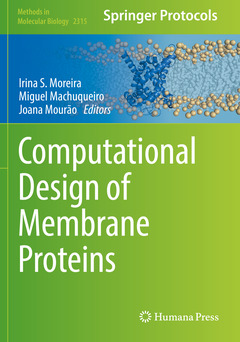Computational Design of Membrane Proteins, 1st ed. 2021 Methods in Molecular Biology Series, Vol. 2315
Coordonnateurs : Moreira Irina S., Machuqueiro Miguel, Mourão Joana

This volume provides an overview of the current successes as well as pitfalls and caveats that are hindering the design of membrane proteins. Divided into six parts, chapters detail membrane transporter, FoldX force field, protein stability, G-Protein Coupled Receptors (GPCR) structures, transmembrane helices, membrane molecular dynamics (MD) simulations, pH-dependent protonation states, membrane permeability, and passive transport. Written in the highly successful Methods in Molecular Biology series format, chapters include introductions to their respective topics, lists of the necessary materials and reagents, step-by-step, readily reproducible laboratory protocols, and tips on troubleshooting and avoiding known pitfalls.
Authoritative and cutting-edge, Computational Design of Membrane Proteins aims to ensure successful results in the further study of this vital field.
Chapter 4 is available open access under a Creative Commons Attribution 4.0 International License via link.springer.com.
PART I: INTRODUCTION
1 Guardians of the Cell: State-of-the-Art of Membrane Proteins from a Computational Point-of-View
Nícia Rosário-Ferreira, Catarina Marques-Pereira, Raquel P. Gouveia, Joana Mourão, and Irina S. Moreira
PART II METHODS IN SYNTHETIC BIOLOGY
2 Integrating Membrane Transporter Proteins into Droplet Interface Bilayers
Heather E. Findlay, Nicola J. Harris, and Paula J. Booth
3 Membrane Protein Engineering with Rosetta
Rebecca F. Alford and Jeffrey J. Gray
4 Engineering of Biological Pathways: Complex Formation and Signal Transduction
Philipp Junk and Christina Kiel
PART III STRUCTURE PREDICTION AND OLIGOMERIZATION
5 Homology Modeling of Class a G-protein-coupled Receptors in the Age of the Structure Boom
Asma Tiss, Rym Ben Boubaker, Daniel Henrion, Hajer Guissouma, and Marie Chabbert
6 Interface Prediction for GPCR Oligomerization between Transmembrane Helices
Wataru Nemoto and Akira Saito
7 Memdock: An α-Helical Membrane Protein Docking Algorithm
Naama Hurwitz and Haim J. Wolfson
PART IV COARSE-GRAINED AND ATOMISTIC MD SIMULATIONS
8 Identification and Characterization of specific Protein-Lipid Interactions using Molecular Simulation
Robin A. Corey, Mark S. P. Sansom, and Phillip J. Stansfeld
9 Molecular Dynamics Simulation of Lipid-modified Signaling Proteins
Vinay Nair and Alemayehu A. Gorfe
10 In silico Prediction of the Binding, Folding, Insertion, and Overall Stability of Membrane-Active Peptides
Nicolas Frazee, Violeta Burns, Chitrak Gupta, and Blake Mertz
PART V PH AND POLARIZATION EFFECTS
11 pKa Calculations in Membrane Proteins from Molecular Dynamics Simulations
Nuno F. B. Oliveira, Tomás F. D. Silva, Pedro B. P. S. Reis, and Miguel Machuqueiro
12 Poor person’s pH Simulation of Membrane Proteins
Chitrak Gupta, Umesh Khaniya, John W. Vant, Mrinal Shekhar, Junjun Mao, M. R. Gunner, and Abhishek Singharoy
13 Preparing and Analyzing Polarizable Molecular Dynamics Simulations with the Classical Drude Oscillator Model
Justin Lemkul
PART VI MEMBRANE PERMEABILITY AND TRANSPORT
14 In silico Prediction of Permeability Coefficients
Ricardo J. Ferreira
15 Identification of Pan Assay INterference compoundS (PAINS) using an MD-Based Protocol
Pedro R. Magalhães, Pedro B. P. S. Reis, Diogo Vila-Viçosa, Miguel Machuqueiro, and Bruno Victor
16 Transmembrane Anion Transport Mediated by Halogen Bonds: using Off-Center Charges
Paulo J. Costa
Includes cutting-edge methods and protocols
Provides step-by-step detail essential for reproducible results
Contains key notes and implementation advice from the experts
Date de parution : 07-2022
Ouvrage de 290 p.
17.8x25.4 cm
Date de parution : 07-2021
Ouvrage de 290 p.
17.8x25.4 cm



